Internet of Things Platform for Energy Management in Multi-Microgrid System to Improve Neutral Current Compensation
Abstract
:1. Introduction
- develop and implement an improved dynamic NCC method for MMG operation
- propose a hierarchical communication platform linking traditional communication layer to IoT operation layer
- present contribution of IoT in MMG operation
- propose communication system operation algorithm for MMG
- investigate the role of communication delay on NCC in MMG operation
2. System Description
3. Multi-Microgrid Control System
3.1. Data Collection
3.2. Active Power Operation
3.3. Reactive Power Operation
3.4. Neutral Current Compensation
3.5. Neutral Current Compensation + Sharing
4. Multi-Microgrid Internet of Things Platform
4.1. Local Communication Level
Modbus TCP/IP
4.2. Global Communication Level
4.2.1. MQTT
- MQTT publisher
- MQTT subscriber
- MQTT broker
4.2.2. HTTP Protocol for Cloud Interactions
4.2.3. Network Emulation in the Platform
5. Communication System Operation Algorithm
5.1. Centralized Communication Mode
5.2. Decentralized Communication Mode
5.2.1. Local–Global
5.2.2. Global
5.3. Distributed Communication Mode
5.4. No Communication Mode
6. Results
6.1. MMG Control System Performance Under the Hierarchical Communication System
6.2. Effect of Communication Delay on NCC
6.2.1. Case Ba: 250 ms ≤ Communication Delay < 350 ms
6.2.2. Case Bb: 350 ms ≤ Communication Delay < 500 ms
6.2.3. Case Bc: Communication Delay ≥ 500 ms
7. Discussion
8. Conclusions
Author Contributions
Funding
Conflicts of Interest
References
- Patel, S.; Hmurcik, L. Preventable ground wire accidents and fires. In Proceedings of the 2016 IEEE 16th International Conference on Environment and Electrical Engineering (EEEIC), Florence, Italy, 7–10 June 2016. [Google Scholar]
- Ijjada, D.; Agarwal, P.; Das, B. Neutral current compensation in three-phase, four-wire systems: A review. Electr. Power Syst. Res. 2012, 86, 170–180. [Google Scholar]
- Moghimi, M.; Rafi, F.H.; Jamborsalamati, P.; Liu, J.; Hossain, M.J.; Lu, J. Improved Unbalance Compensation for Energy Management in Multi-Microgrid System with Internet of Things Platform. In Proceedings of the 18th IEEE International Conference on Environment and Electrical Engineering (IEEE EEEIC18), Palermo, Italy, 12–15 June 2018. [Google Scholar]
- Pattnaik, M.; Kastha, D. Harmonic Compensation With Zero-Sequence Load Voltage Control in a Speed-Sensorless DFIG-Based Stand-Alone VSCF Generating System. IEEE Trans. Ind. Electron. 2013, 60, 5506–5514. [Google Scholar] [CrossRef]
- Alam, M.J.E.; Muttaqi, K.M.; Sutanto, D. Alleviation of Neutral-to-Ground Potential Rise Under Unbalanced Allocation of Rooftop PV Using Distributed Energy Storage. IEEE Trans. Sustain. Energy 2015, 6, 889–898. [Google Scholar] [CrossRef]
- Singh, M.; Khadkikar, V.; Chandra, A.; Varma, R.K. Grid Interconnection of Renewable Energy Sources at the Distribution Level With Power-Quality Improvement Features. IEEE Trans. Power Deliv. 2011, 26, 307–315. [Google Scholar] [CrossRef]
- Rafi, F.H.M.; Hossain, M.J.; Lu, J. Improved Neutral Current Compensation With a Four-Leg PV Smart VSI in a LV Residential Network. IEEE Trans. Power Deliv. 2017, 32, 2291–2302. [Google Scholar] [CrossRef]
- Guo, X.; He, R.; Jian, J.; Lu, Z.; Sun, X.; Guerrero, J.M. Leakage Current Elimination of Four-Leg Inverter for Transformerless Three-Phase PV Systems. IEEE Trans. Power Electron. 2016, 31, 1841–1846. [Google Scholar] [CrossRef] [Green Version]
- Hossain, J.; Rafi, F.; Town, G.; Lu, J. Multifunctional Three-Phase Four-Leg PV-SVSI with Dynamic Capacity Distribution Method. IEEE Trans. Ind. Inform. 2018, 14, 2507–2520. [Google Scholar] [CrossRef]
- Al-Saedi, W.; Lachowicz, S.W.; Habibi, D.; Bass, O. Power quality enhancement in autonomous microgrid operation using Particle Swarm Optimization. Int. J. Electr. Power Energy Syst. 2012, 42, 139–149. [Google Scholar] [CrossRef]
- Burgos-Mellado, C.; Hernández-Carimán, C.; Cárdenas, R.; Sáez, D.; Sumner, M.; Costabeber, A.; Paredes, H.K.M. Experimental Evaluation of a CPT-Based Four-Leg Active Power Compensator for Distributed Generation. IEEE J. Emerg. Sel. Top. Power Electron. 2017, 5, 747–759. [Google Scholar] [CrossRef] [Green Version]
- Lee, Y.T.; Hsiao, W.H.; Huang, C.M.; Chou, S.T. An integrated cloud-based smart home management system with community hierarchy. IEEE Trans. Consum. Electron. 2016, 62, 1–9. [Google Scholar] [CrossRef]
- Byun, J.; Hong, I.; Park, S. Intelligent cloud home energy management system using household appliance priority based scheduling based on prediction of renewable energy capability. IEEE Trans. Consum. Electron. 2012, 58, 1194–1201. [Google Scholar] [CrossRef]
- Chen, Y.; Chang, J.M. EMaaS: Cloud-Based Energy Management Service for Distributed Renewable Energy Integration. IEEE Trans. Smart Grid 2015, 6, 2816–2824. [Google Scholar] [CrossRef]
- Byun, J.; Kim, Y.; Hwang, Z.; Park, S. An intelligent cloud-based energy management system using machine to machine communications in future energy environments. In Proceedings of the 2012 IEEE International Conference on Consumer Electronics (ICCE), Las Vegas, NV, USA, 13–16 January 2012. [Google Scholar]
- Suciu, G.; Fratu, O.; Necula, L.; Pasat, A.; Suciu, V. Machine-to-Machine communications for Cloud-based energy management systems within SMEs. In Proceedings of the 2016 IEEE 22nd International Symposium for Design and Technology in Electronic Packaging (SIITME), Oradea, Romania, 20–23 October 2016. [Google Scholar]
- Jamborsalamati, P.; Fernandez, E.; Moghimi, M.; Hossain, M.J.; Heidari, A.; Lu, J. MQTT-Based Resource Allocation of Smart Buildings for Grid Demand Reduction Considering Unreliable Communication Links. IEEE Syst. J. 2018, 1–12. [Google Scholar] [CrossRef]
- Available online: https://hvdc.ca/knowledge-base/v: (accessed on 11 September 2018).
- Moghimi, M.; Bennett, C.; Leskarac, D.; Stegen, S.; Lu, J. Communication architecture and data acquisition for experimental MicroGrid installations. In Proceedings of the 2015 IEEE PES Asia-Pacific Power and Energy Engineering Conference (APPEEC), Brisbane, QLD, Australia, 15–18 November 2015. [Google Scholar]
- Available online: http://mqtt.org/ (accessed on 11 September 2018).
- Dizdarevic, J.; Carpio, F.; Jukan, A.; Masip-Bruin, X. Survey of communication protocols for Internet-of-Things and related challenges of fog and cloud computing integration. arXiv, 2018; arXiv:1804.01747. [Google Scholar]
- Modbus Messaging Implementation Guide Version1_0a. Available online: http://www.modbus.org/docs/Modbus_Messaging_Implementation_Guide_V1_0a.pdf (accessed on 11 September 2018).
- Guo, Y.; Pan, M.; Fang, Y.; Khargonekar, P.P. Decentralized Coordination of Energy Utilization for Residential Households in the Smart Grid. IEEE Trans. Smart Grid 2013, 4, 1341–1350. [Google Scholar] [CrossRef]
- Available online: http://www.eclipse.org/paho/ (accessed on 11 September 2018).
- Available online: http://thingspeak.com/ (accessed on 11 September 2018).
- Manbachi, M.; Sadu, A.; Farhangi, H.; Monti, A.; Palizban, A.; Ponci, F.; Arzanpour, S. Real-time communication platform for Smart Grid adaptive Volt-VAR Optimization of distribution networks. In Proceedings of the 2015 IEEE International Conference on Smart Energy Grid Engineering (SEGE), Oshawa, ON, Canada, 17–19 August 2015. [Google Scholar]
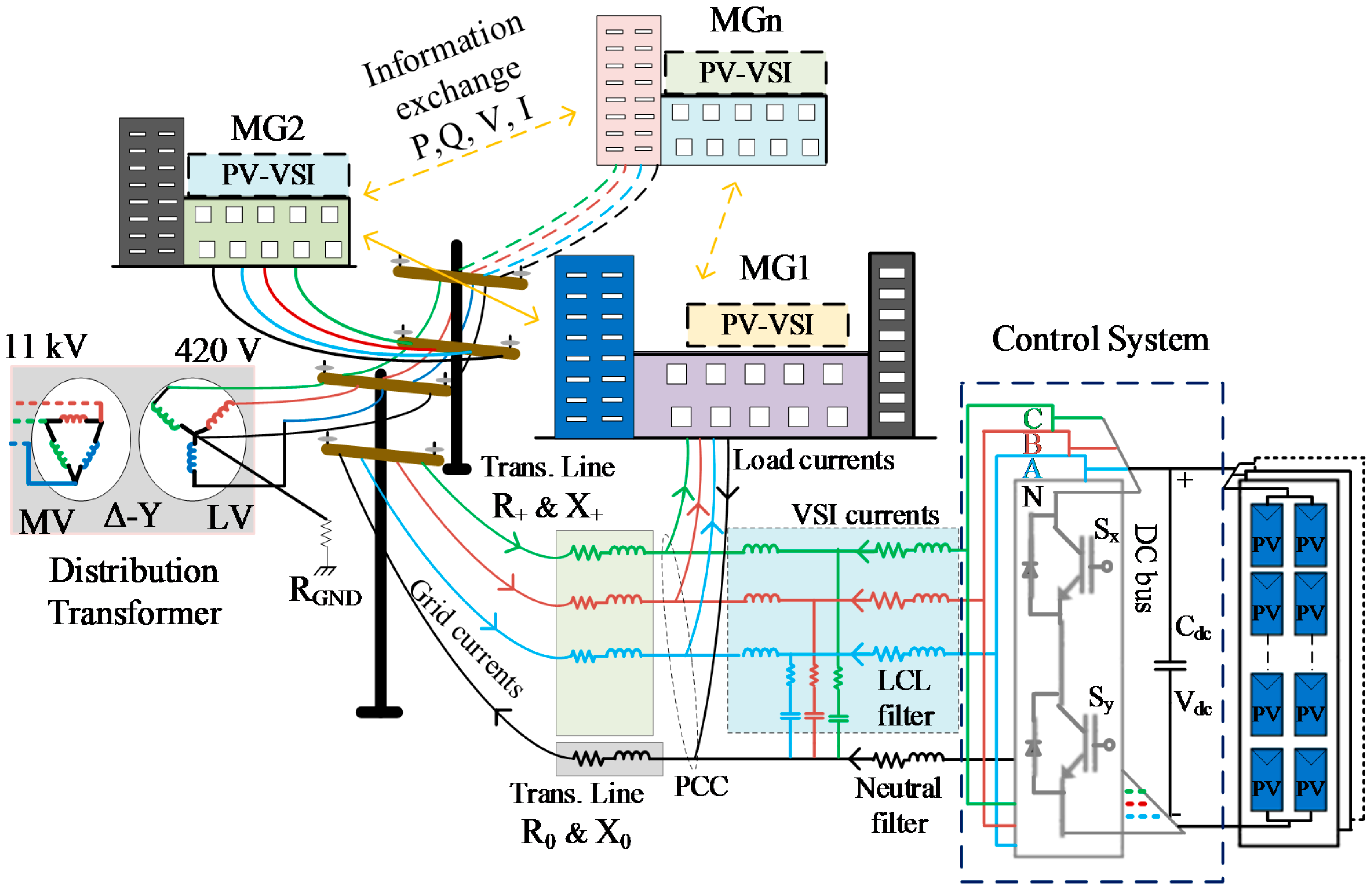

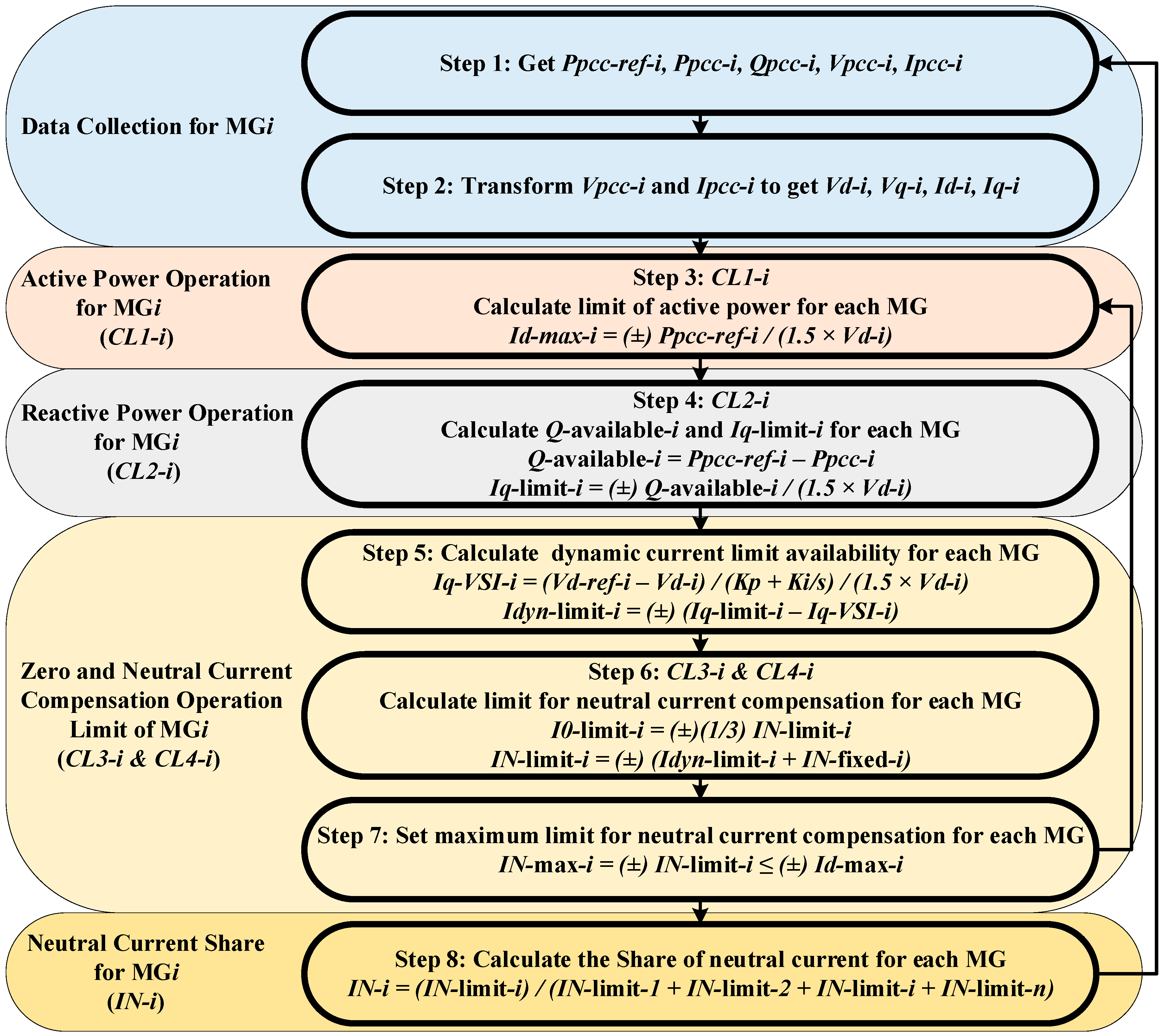

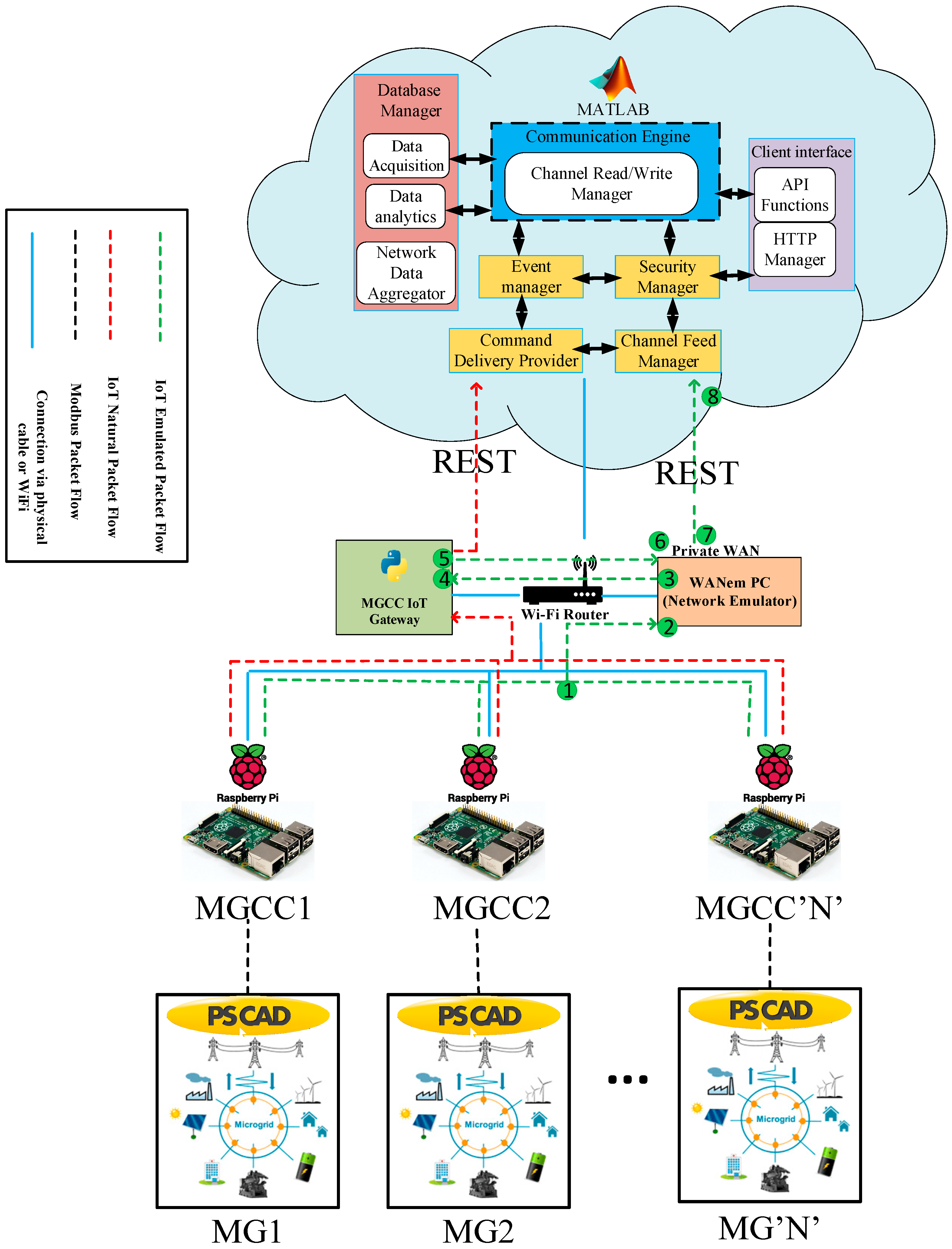
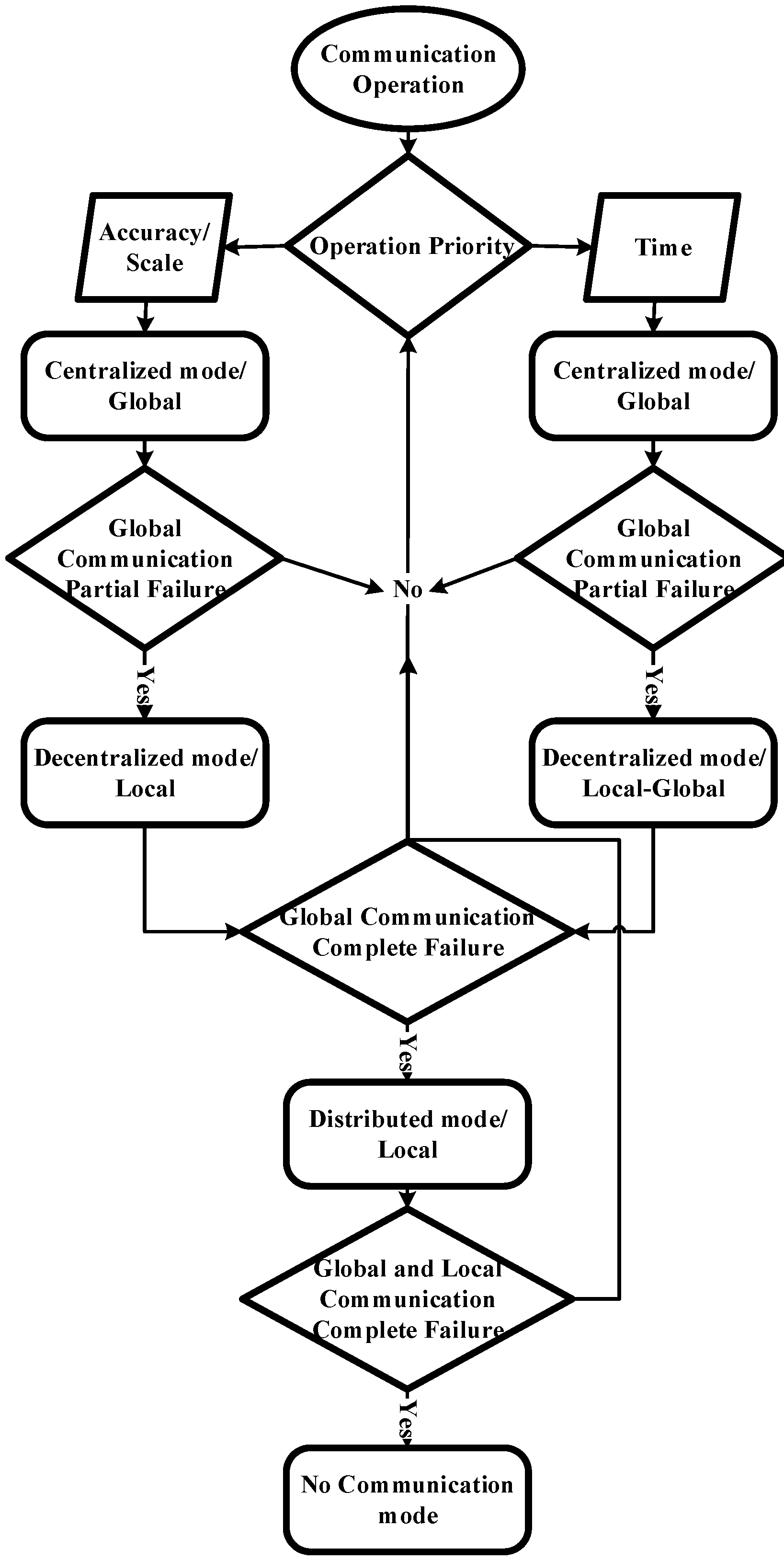
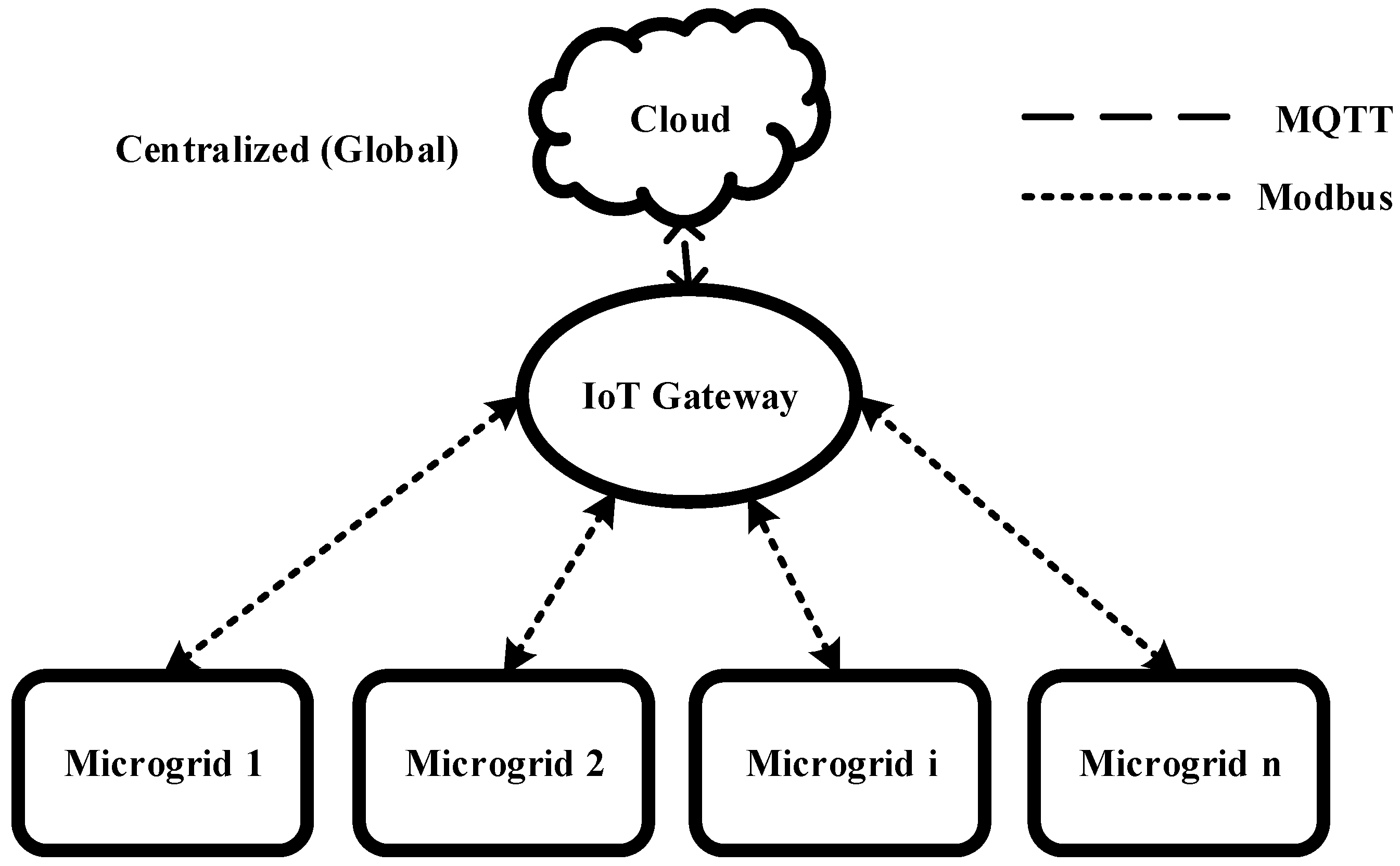
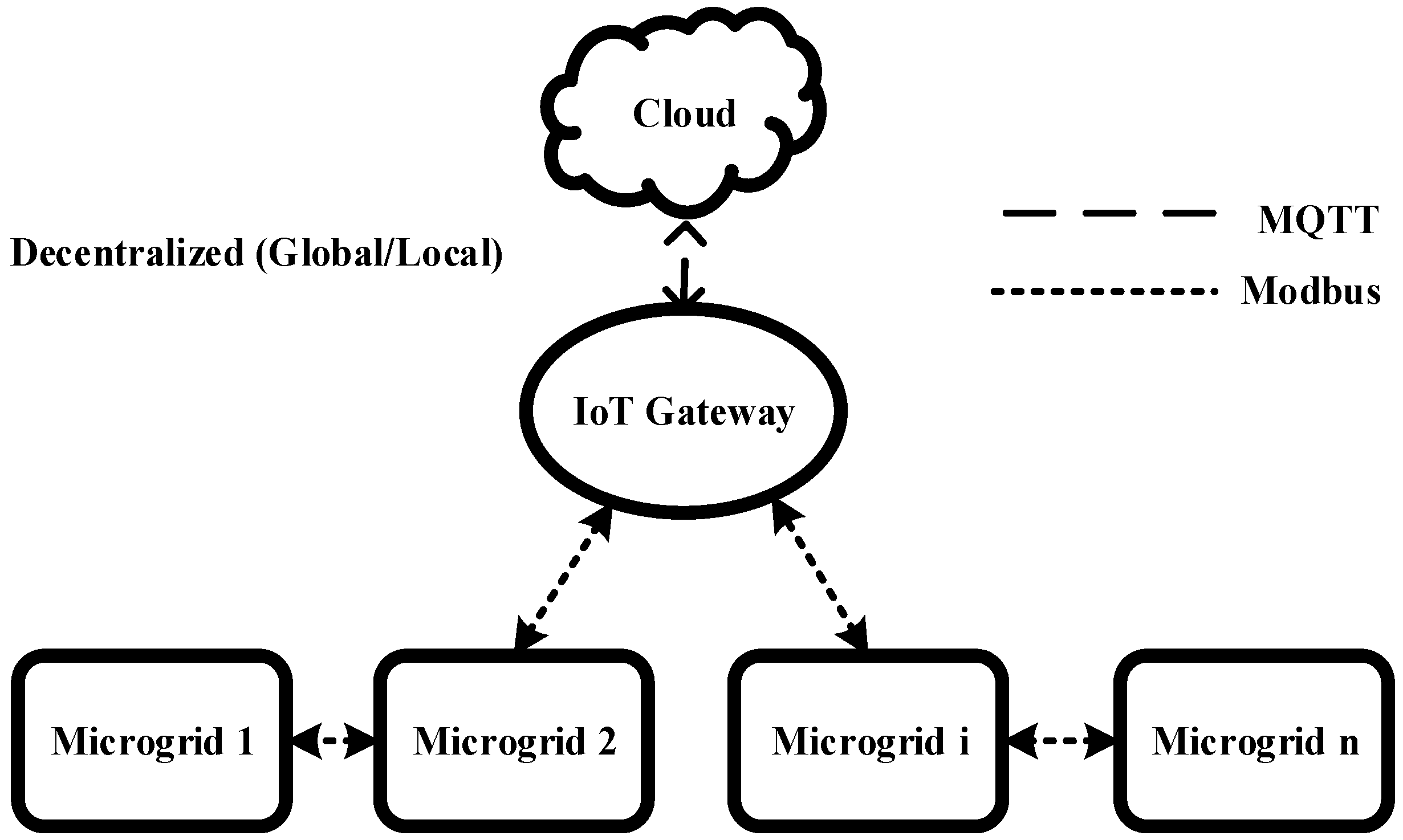


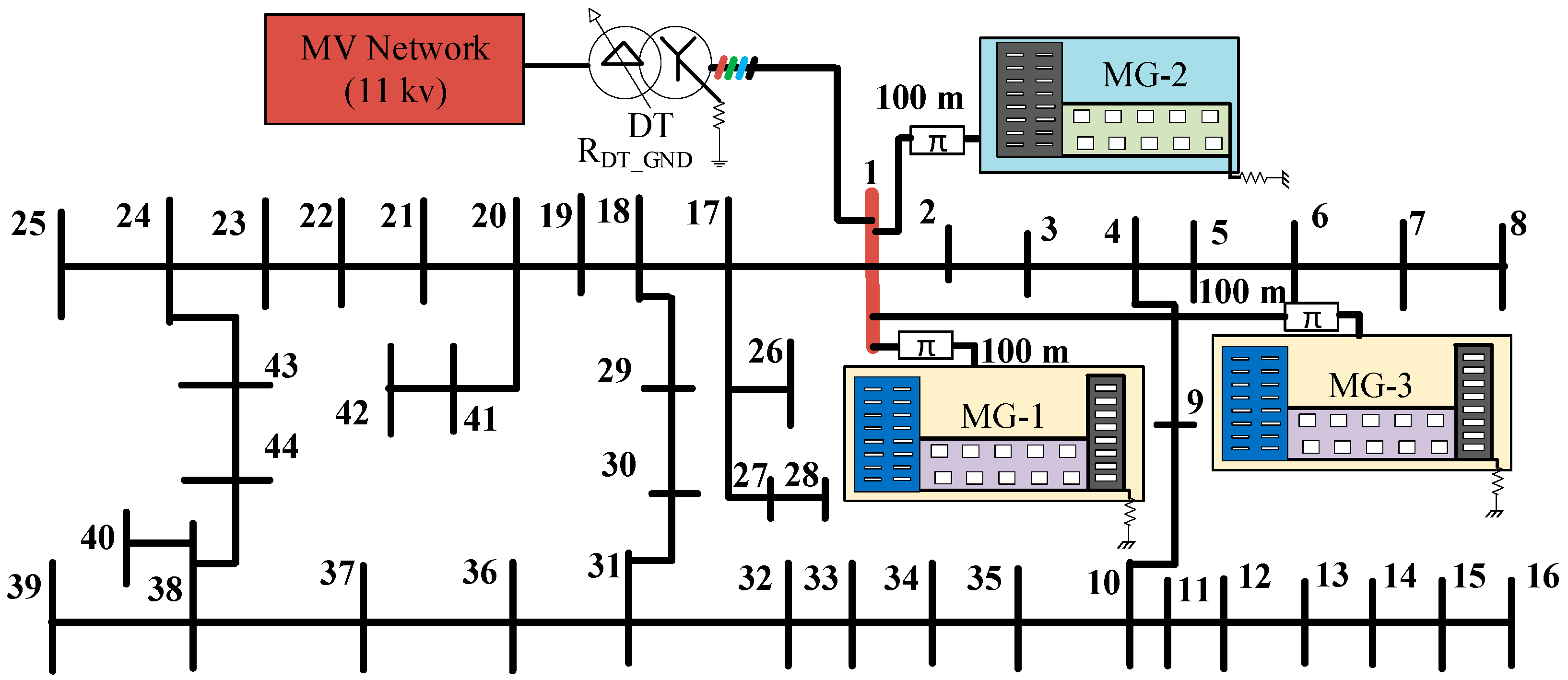



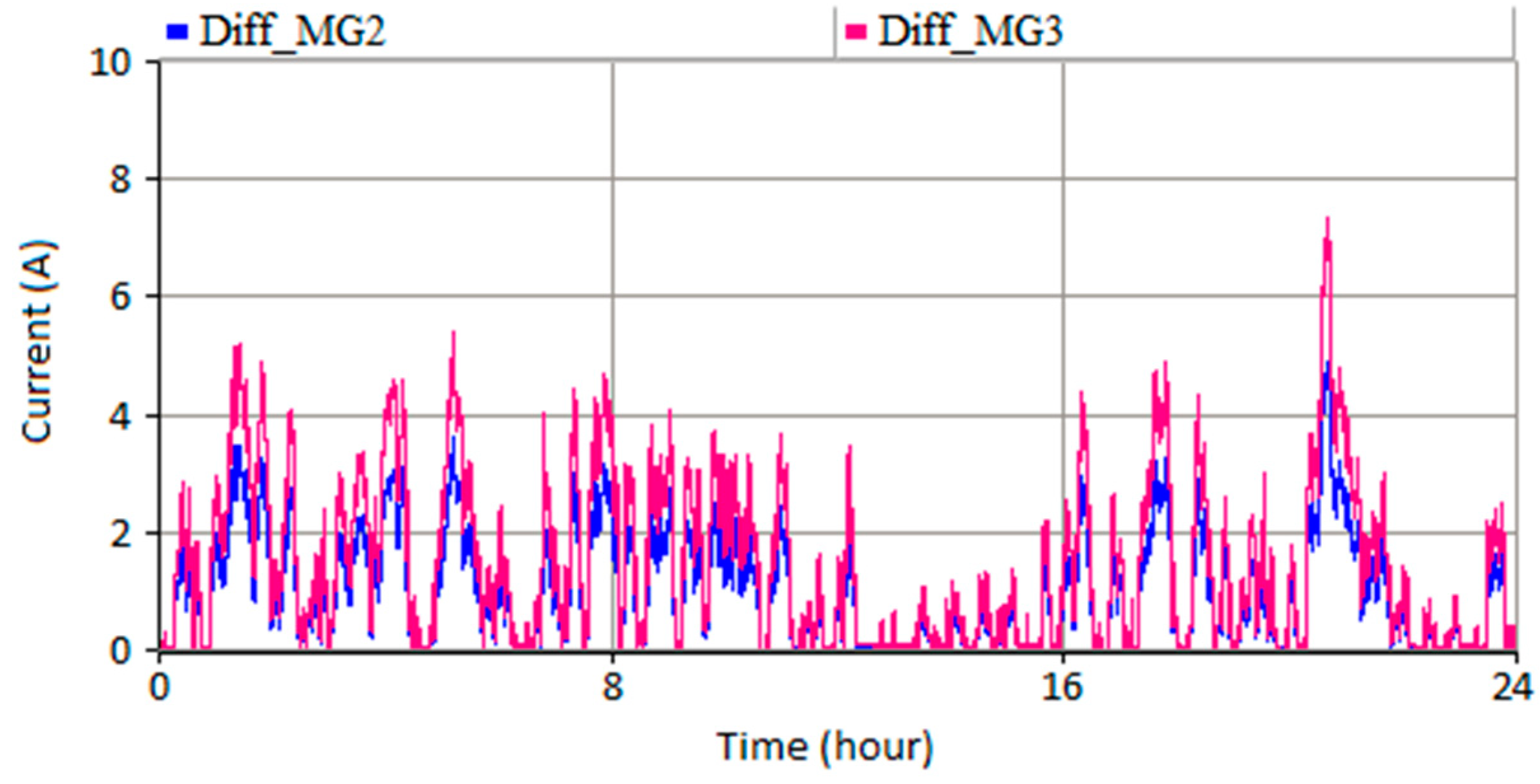






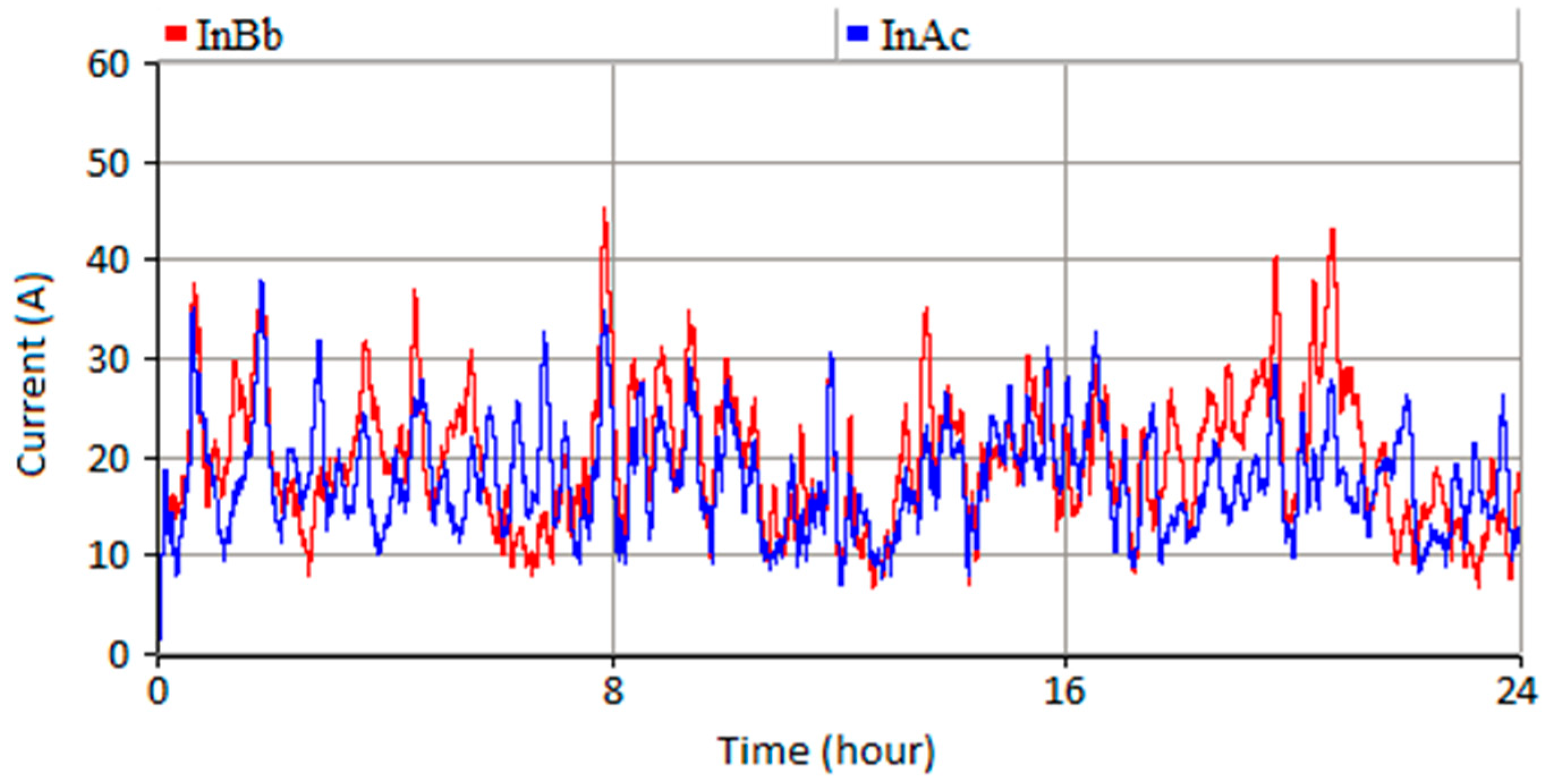
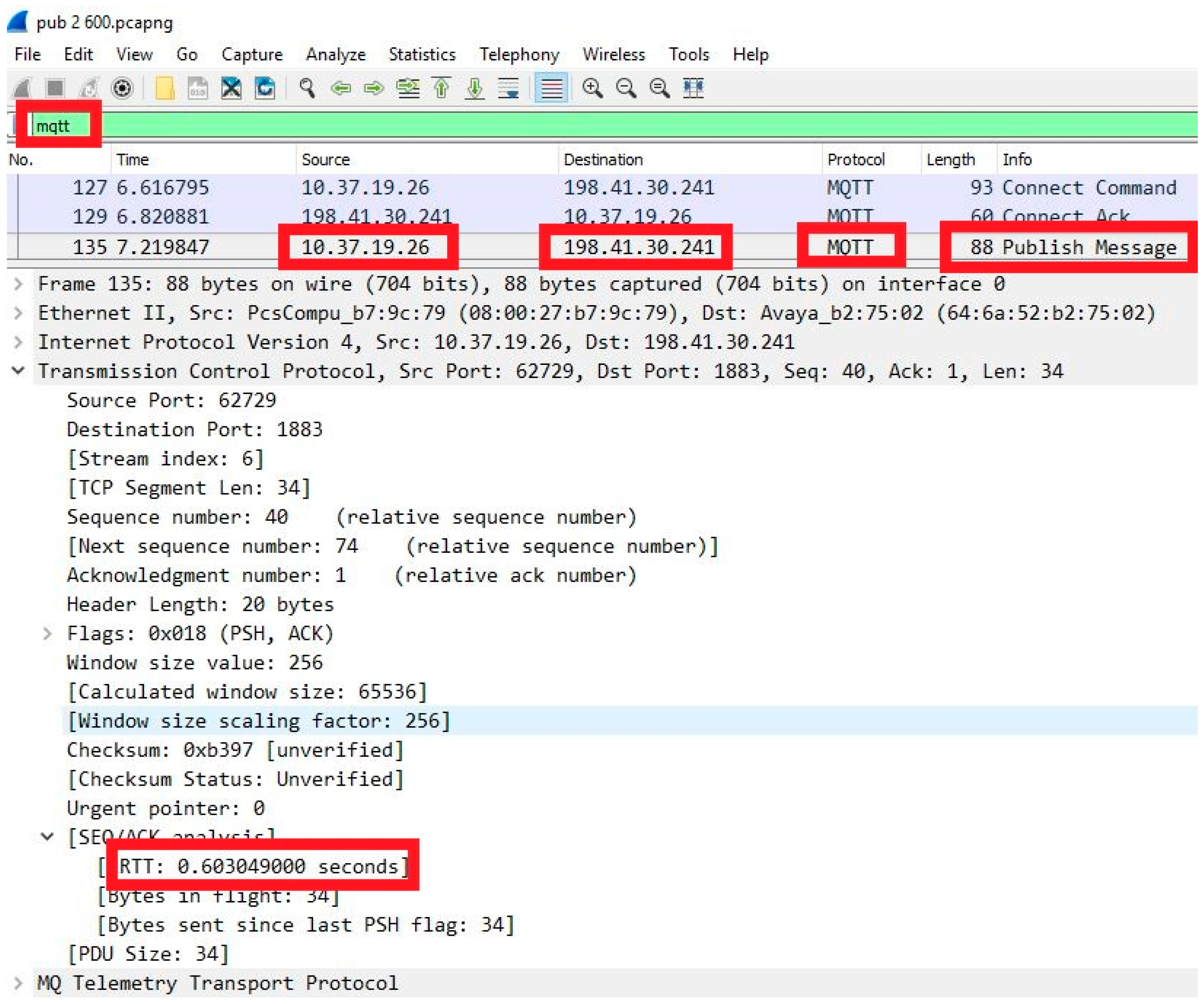

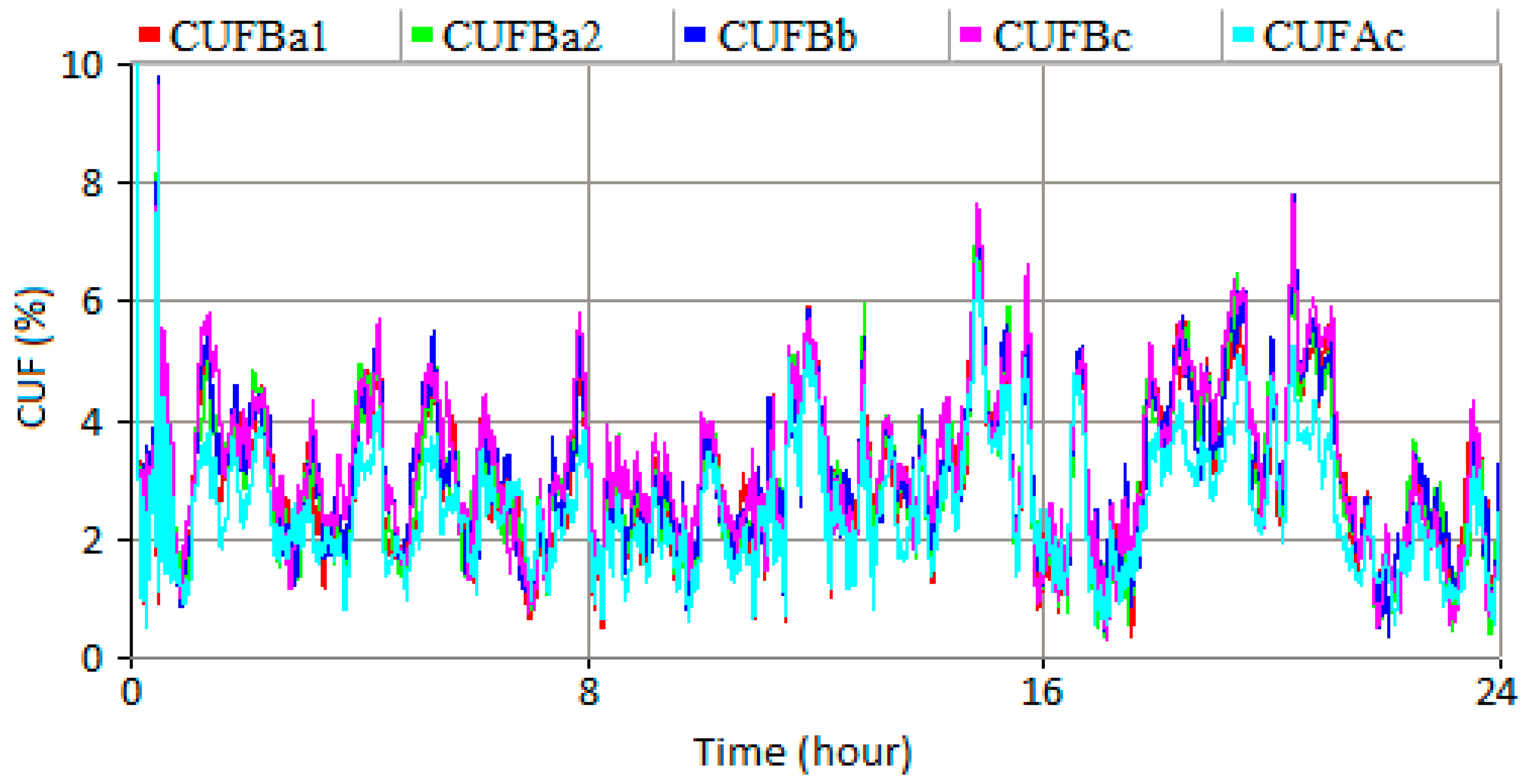
| RTT | Communication Operation Mode |
|---|---|
| centralized communication mode | |
| decentralized communication mode/global | |
| decentralized communication mode/local-global | |
| distributed communication mode | |
| no communication mode |
| Scenarios | Configuration of MGs |
|---|---|
| Case Aa | Aa1. MG1 with 10 kW PV and 10A fixed neutral compensation |
| Aa2. MG2 with 10 kW PV and dynamic neutral compensation | |
| Aa3. MG3 with 10 kW PV and dynamic neutral compensation | |
| Case Ab | Ab1. MG1 with 10 kW PV and dynamic neutral compensation |
| Ab2. MG2 with 10 kW PV and dynamic neutral compensation | |
| Ab3. MG3 with 15 kW PV and dynamic neutral compensation | |
| Case Ac | Ac1. MG1 with 10 kW PV and 10 A fixed neutral compensation |
| Ac2. MG2 with 10 kW PV and dynamic NCC + sharing | |
| Ac3. MG3 with 15 kW PV and dynamic NCC + sharing |
| Scenarios | Communication Delay (CD) |
|---|---|
| Case Ba | 250 ms ≤ CD < 350 ms |
| Case Bb | 350 ms ≤ CD < 500 ms |
| Case Bc | CD ≥ 500 ms |
© 2018 by the authors. Licensee MDPI, Basel, Switzerland. This article is an open access article distributed under the terms and conditions of the Creative Commons Attribution (CC BY) license (http://creativecommons.org/licenses/by/4.0/).
Share and Cite
Moghimi, M.; Liu, J.; Jamborsalamati, P.; Rafi, F.H.M.; Rahman, S.; Hossain, J.; Stegen, S.; Lu, J. Internet of Things Platform for Energy Management in Multi-Microgrid System to Improve Neutral Current Compensation. Energies 2018, 11, 3102. https://doi.org/10.3390/en11113102
Moghimi M, Liu J, Jamborsalamati P, Rafi FHM, Rahman S, Hossain J, Stegen S, Lu J. Internet of Things Platform for Energy Management in Multi-Microgrid System to Improve Neutral Current Compensation. Energies. 2018; 11(11):3102. https://doi.org/10.3390/en11113102
Chicago/Turabian StyleMoghimi, Mojtaba, Jiannan Liu, Pouya Jamborsalamati, Fida Hasan Md Rafi, Shihanur Rahman, Jahangir Hossain, Sascha Stegen, and Junwei Lu. 2018. "Internet of Things Platform for Energy Management in Multi-Microgrid System to Improve Neutral Current Compensation" Energies 11, no. 11: 3102. https://doi.org/10.3390/en11113102
APA StyleMoghimi, M., Liu, J., Jamborsalamati, P., Rafi, F. H. M., Rahman, S., Hossain, J., Stegen, S., & Lu, J. (2018). Internet of Things Platform for Energy Management in Multi-Microgrid System to Improve Neutral Current Compensation. Energies, 11(11), 3102. https://doi.org/10.3390/en11113102







